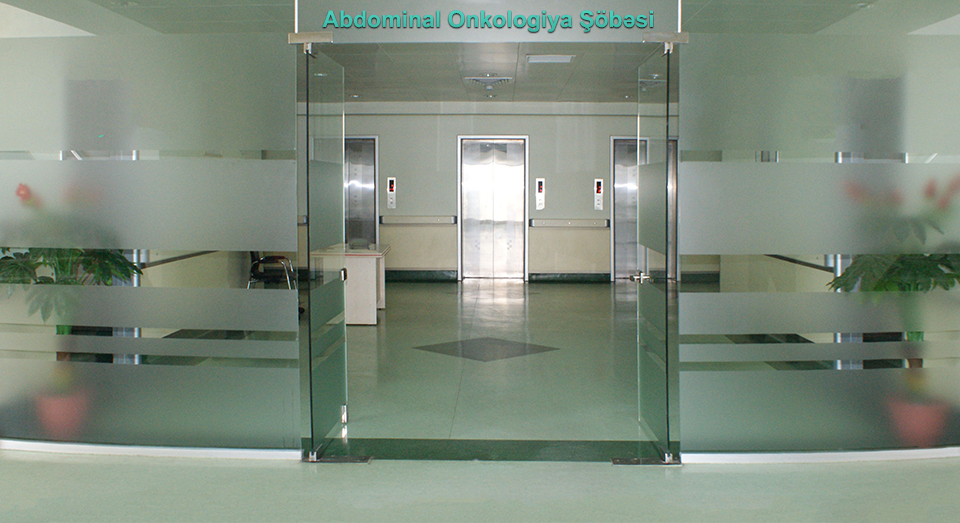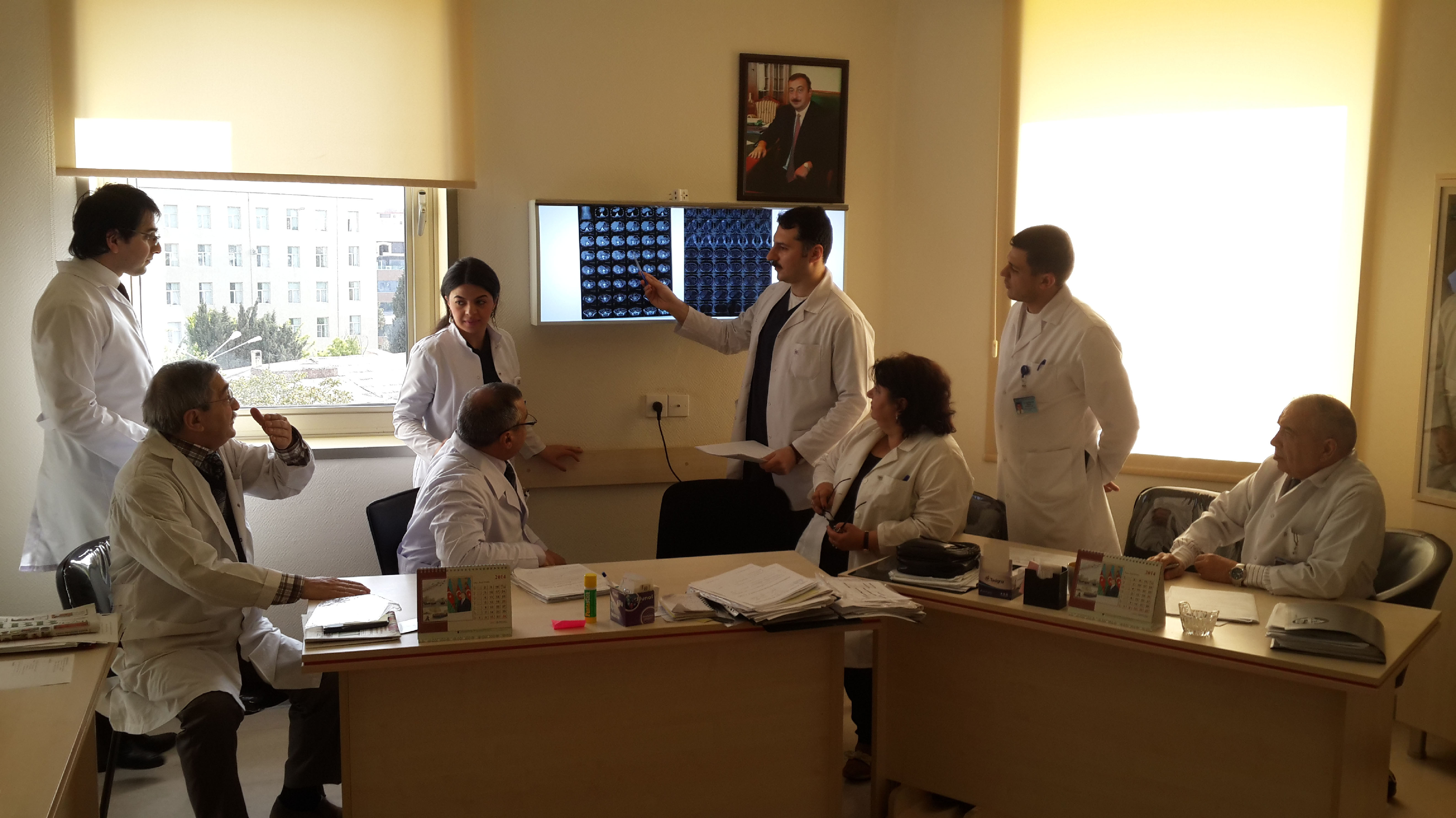Department of Abdominal Oncology

Department of abdominal oncology was one of the first departments of the National Center of Oncology. Earlier it included also oncourology and oncoginecology departments but after opening the new surgical building they began to function like independent departments.
Department of abdominal oncology is located on the 4th floor of the surgical unit of the National Center of Oncology. Bedspace of department consists of 61 beds that are distributed in 22 rooms. In addition to that, for a good treatment and health of patients in the department there are 4 wound dressing, 2 manipulation, 2 examination rooms and 2 kitchens. Department employs 14 doctors, 17 nurses and 13 nursing orderly. Doctors periodically go to countries like Germany, Austria, Turkey, Russia, Italy, France for the purpose of education, professional training and participation in International Congress of Oncologists. The doctor staff of department actively engages in scientific research, publishes scientific articles and theses, makes reports at International Conferences of Oncologists, takes part in sharing experience.
Also, on program of sharing of experience the senior doctor staff of appropriate scope from Europe are often invited to department of abdominal oncology. Young doctors of department are fluent in English, Russian and Turkish. In addition, for the department of abdominal oncology in the operating unit that is on the 7th floor of the surgical unit assigned three operating rooms. Operating unit is rebuilt and equipped on modern standards, enabling all kinds of surgical procedures, including laparoscopic ones.
As seen from the name of department, it specializes in the treatment of tumors of the abdominal cavity, chest, retroperitoneal space, esophagus. Patients after a meticulous examination in the diagnostic unit and consultation of cancer-surgeon are hospitalized to the department of abdominal oncology for in-patient treatment.
The medical histories of every new-admitted patient are co-discussed with the department director, professor and team of doctors of department, after which the tactics of further examination and treatment of patients are determined.
During the year in the department of abdominal oncology more than 800 patients are examined and treated. Among them 700 patients underwent surgical management. Thus, surgical activity of department was 87-90%. 90-92% of them underwent surgery for oncological diseases, among which ~ 92% due to malignant and ~ 8% due to benign tumors, and 8-10% – non-cancer surgical diseases. Routinely performed for about 90% of operations. Overall mortality in department was 2.7%, post-operative – 2.5%.
Surgery of stomach malignances :
During the year, on the subject of tumors of the stomach underwent surgical management about 150 patients. Stomach cancer met in ~ 93%, benign tumors – in ~ 7% of cases. Majority (~ 86%) of performed surgical operations were:
- Qastrectomy, limfodisseksion D2-D3
- Distal subtotal resection of stomach, limfodisseksion D2-D3
- Extended operations.
About 83% of operations were radical. Radical operations in 18-20% of cases were combined, i.e. gastrectomy with resection of the abdominal segment of the esophagus, gastrectomy with the liver resection, distal or subtotal gastric resection with various types of resection of pancreas. Reconstructive step in gastrectomies are performed by Roux, and with it esophago-jejunoanastomosis is formed by circular surgical stapling instrument. In gastrectomy with resection of esophagus on the subject of cardioesofageal cancer sagittal diafragmotomy is performing.
Surgery of colon cancer :
- During the year, on subject of diseases of the colon were operated on 150 patients. Among patients colon cancer met in ~ 95%, benign tumors – in 4.5% of cases, the remaining patients were diagnosed with non-cancer diseases. Majority (~ 60%) of surgery performed was:
- Righti hemicolectomy
- Left hemicolectomy
- Resection of Siqma
In addition to the above operations :
- Total colektomy
- Subtotal colectomy
- Combine operations
- Reconstructiv operations
Syimptomatic procedures.
Radical surgical management performed in ~ 90% of cases.
Surgery of rectal cancer :
On subject of the diseases of the rectum during the year underwent surgical management over 140 patients. About 95% of patients were operated on rectal cancer, and the rest – on rectal polyp. Among performed surgeries occur:
- anterior resection
- the lower anterior resection
- abdominoanal resection of rectum
- resection of the rectum by Hartmann-Inoyatov
- abdominoperineal resection of rectum
- combined operations
- reconstructive surgery
- transanal polypectomy .
In this case, 86% of operations were radical. Patients with cancer of rectum, depending on the stage of the disease, in preoperative and/or postoperative period carry out radiotherapy and/or chemotherapy.
On patients with colorectal cancer in the late stages the main objective of palliative surgery is to create a colostomy. In most cases, palliative surgery prevents from cancer intoxication and signs of bowel obstruction, and thus way creates the conditions for radiotherapy and/or chemotherapy.
Surgery of liver :
On subject of liver disease during the year were operated on about 25 patients. Among them 65% had cancer, 30% – benign tumors (adenoma, hemangioma), 1 patient – hydatid cyst of the liver. Performed surgery:
- right hemihepatectomy
- left hemihepatectomy,
- extended hemihepatectomy
- bisegmentektomy
- atypical liver resection
- laparoscopic biopsy
- liver resection with cholecystectomy and choledochoduodenostomy. During the last 4 years in the department were performed five extended and 12 right or left hemihepatectomies.
Surgery of galebladder :
On subject of gallbladder diseases in 1 year surgical management performed about to 40 patients. Patients with non-cancer diagnosis are dominated (~ 80%). Malignant diseases are met in ~ 15%, benign – in ~ 5%.
Most of the surgery were :
- laparoscopic cholecystectomy.
- laparoscopic cholecystectomy with resection of bladder bed.
Surgery of extrahepatic bile ducts :
During the year, 6 patients underwent surgery for a malignant tumor, 1 patient – for benign tumor of the extrahepatic bile ducts. Among performed operations occur:
- resection of choledochus with hepatico-jejunostomy
- resection of choledochus with bihepatico-jejunostomy
- transhepatic choledochostomy.
Surgery of spleen :
During the year, the radical splenectomy performed in 6 patients with benign tumors of the spleen, and in 3 patients with its lymphoma. Two of these operations performed by laparoscopic method.
Surgery of pancreas :
During the last year 24 patients with the diseases of the pancreas underwent various surgical interventions. The majority of patients had a diagnosis of pancreatic cancer. About 40% of operations were radical :
- gastropancreatoduodenal resection (5 patients)
- distal pancreatectomy (4 patients). The palliative operations were bypass operations on gallbladder and common bile duct, cholecystostomy and percutaneous transhepatic cholangiostomy.
- Due to pancreatic cysts two patients underwent cystectomy.
Surgery of duodenum and papilla Vateri :
During the year on surgical management were 14 patients with diseases of duodenum and the major duodenal papilla.
- Pancreatoduodenal resection (3 patients)
- Qastroenterostomy (4 patients) .
- Duodenotomy, resection of tumor with wirsunqoxoledoxoplastika icra edilmişdir (3patientswith the adenom of papilla Vateri).
With the diagnosis of duodenal ulcer 5 patients underwent surgical management – closing the perforated hole, excision of ulcer crater with following pyloroplasty.
Surgery of retroperitoneal space :
For tumors of the retroperitoneal space in last year 28 patients underwent a various surgical procedures. Malignant tumors were diagnosed in 90% of them. In 4 of every 5 patients tumor removal occured possible, the vast majority of these patients underwent combined operations, i.e. surgery supplemented with the resection of one or two neighbour organs. Also laparoscopic and “open” biopsy of tumors were performed.
The palliative procedures such as colostomy , by-pass anastomosis, cholangiostomy were performed by patients with extended cases where radical operations are impossible. The main aim of this procedures was to improve quality of life of this patients and to create favorable conditions for radio- and chemotherapy.
As noted above, the mortality rate in department of abdominal oncology is very low. The medical histories of each death-marked patient are discussed in Medical Control Commission of the National Center of Oncology.
Laparoscopic surgery :
Attention is payed that the rate of laparoscopic operations in the department is increased. Thereby, if in 2012 for malignant tumors 40 laparoscopic procedures were performed, in year 2013 this rate came up to 30, and in the first decade of 2014 the number of procedures was approximately 100 .
- Gastrectomy with limfodissection 3
- Distal subtotal resection with limfodissection 4
- Right hemicolectomy with limfodissection 14
- Left hemicolectomy with limfodissection 8
- Resection of Siqma with limfodissection 17
- Anterior resection of rectum with limfodissection 15
- Abdominal part of APR with limfodissection 2
- Splenectom with limfodissection- 2
- Atipic resection liver with limfodissection – 3
- Cholesystectomy with resection of galebladder bed with limfodissection – 2
- Corporocaudal resection of pancreas , limfodissection – 3
- Cystectomy from pancreas – 7
- Biopsy from galebladder polips, small solid tumors of abdomen and irresectable retroperitoneal tumors.
Non-oncological disease :
- Cholelythiasis
- Hydatid cyst of liver
- Inguinal, femoral and umbilical hernias
- Postoperativ ventral hernias
- GERD



